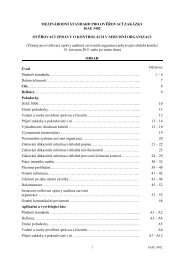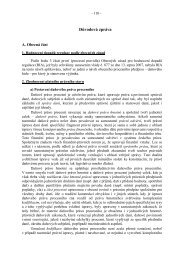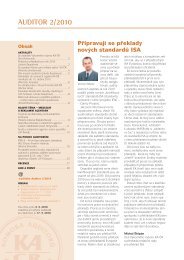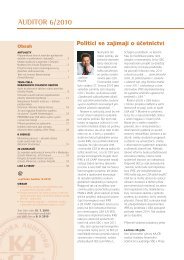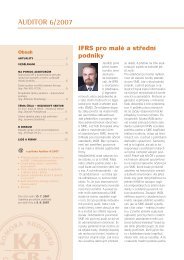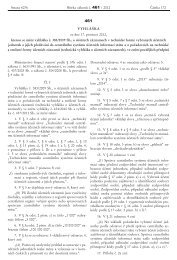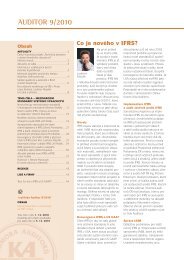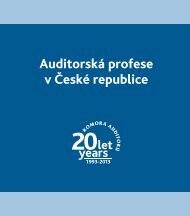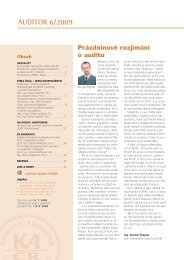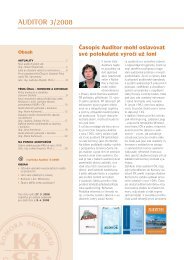Guide to Using International Standards on Auditing in - IFAC
Guide to Using International Standards on Auditing in - IFAC
Guide to Using International Standards on Auditing in - IFAC
You also want an ePaper? Increase the reach of your titles
YUMPU automatically turns print PDFs into web optimized ePapers that Google loves.
88<br />
<str<strong>on</strong>g>Guide</str<strong>on</strong>g> <str<strong>on</strong>g>to</str<strong>on</strong>g> <str<strong>on</strong>g>Us<strong>in</strong>g</str<strong>on</strong>g> <str<strong>on</strong>g>Internati<strong>on</strong>al</str<strong>on</strong>g> <str<strong>on</strong>g>Standards</str<strong>on</strong>g> <strong>on</strong> <strong>Audit<strong>in</strong>g</strong> <strong>in</strong> the Audits of Small- and Medium-Sized Entities Volume 1—Core C<strong>on</strong>cepts<br />
7.4 Materiality and Audit Risk<br />
Materiality (as discussed above) and audit risk are related, and are c<strong>on</strong>sidered <str<strong>on</strong>g>to</str<strong>on</strong>g>gether throughout the audit<br />
process.<br />
Audit risk is the possibility that an audi<str<strong>on</strong>g>to</str<strong>on</strong>g>r expresses an <strong>in</strong>appropriate audit op<strong>in</strong>i<strong>on</strong> <strong>on</strong> f<strong>in</strong>ancial statements<br />
that are materially misstated.<br />
Exhibit 7.4-1<br />
Risks of Material<br />
Misstatement<br />
(RMM)<br />
Detecti<strong>on</strong> Risk<br />
Audit Risk Comp<strong>on</strong>ents<br />
The risk that the f<strong>in</strong>ancial statements are materially misstated prior <str<strong>on</strong>g>to</str<strong>on</strong>g> the start of<br />
any audit work. These risks are c<strong>on</strong>sidered at the f<strong>in</strong>ancial statement level (often<br />
pervasive risks, affect<strong>in</strong>g many asserti<strong>on</strong>s) and at the asserti<strong>on</strong> level, which relates <str<strong>on</strong>g>to</str<strong>on</strong>g><br />
classes of transacti<strong>on</strong>s, account balances, and disclosures. RMM is a comb<strong>in</strong>ati<strong>on</strong> of<br />
<strong>in</strong>herent risk (IR) and c<strong>on</strong>trol risk (CR), which can be summarized as IR x CR = RMM.<br />
The risk that the audi<str<strong>on</strong>g>to</str<strong>on</strong>g>r fails <str<strong>on</strong>g>to</str<strong>on</strong>g> detect a misstatement that exists <strong>in</strong> an asserti<strong>on</strong> that<br />
could be material. Detecti<strong>on</strong> risk (DR) is addressed through:<br />
• Sound audit plann<strong>in</strong>g;<br />
• Perform<strong>in</strong>g audit procedures that resp<strong>on</strong>d <str<strong>on</strong>g>to</str<strong>on</strong>g> the risks of material misstatement<br />
identified;<br />
• Proper assignment of audit pers<strong>on</strong>nel;<br />
• The applicati<strong>on</strong> of professi<strong>on</strong>al skepticism; and<br />
• Supervisi<strong>on</strong> and review of the audit work performed.<br />
Detecti<strong>on</strong> risk can never be reduced <str<strong>on</strong>g>to</str<strong>on</strong>g> zero, because of the <strong>in</strong>herent limitati<strong>on</strong>s <strong>in</strong><br />
the audit procedures carried out, the human judgments (professi<strong>on</strong>al) required, and<br />
the nature of the evidence exam<strong>in</strong>ed.<br />
Audit risk (AR) can therefore be summarized as:<br />
AR = RMM x DR<br />
Materiality and audit risk are c<strong>on</strong>sidered throughout the audit <strong>in</strong>:<br />
• Identify<strong>in</strong>g and assess<strong>in</strong>g the risks of material misstatement;<br />
• Determ<strong>in</strong><strong>in</strong>g the nature, tim<strong>in</strong>g, and extent of further audit procedures;<br />
• Determ<strong>in</strong><strong>in</strong>g revisi<strong>on</strong>s <str<strong>on</strong>g>to</str<strong>on</strong>g> materiality (overall and performance) after becom<strong>in</strong>g aware of new <strong>in</strong>formati<strong>on</strong><br />
dur<strong>in</strong>g the audit, which would have caused the audi<str<strong>on</strong>g>to</str<strong>on</strong>g>r <str<strong>on</strong>g>to</str<strong>on</strong>g> have determ<strong>in</strong>ed a different amount (or<br />
amounts) <strong>in</strong>itially; and<br />
• Evaluat<strong>in</strong>g the effect of uncorrected misstatements, if any, <strong>on</strong> the f<strong>in</strong>ancial statements and <strong>in</strong> form<strong>in</strong>g<br />
the op<strong>in</strong>i<strong>on</strong> <strong>in</strong> the audi<str<strong>on</strong>g>to</str<strong>on</strong>g>r’s report.<br />
<str<strong>on</strong>g>Us<strong>in</strong>g</str<strong>on</strong>g> the simple analogy of a high jump <strong>in</strong> athletics, materiality would be equivalent <str<strong>on</strong>g>to</str<strong>on</strong>g> the height of the<br />
bar the athlete has <str<strong>on</strong>g>to</str<strong>on</strong>g> jump over. Audit risk is equivalent <str<strong>on</strong>g>to</str<strong>on</strong>g> the level of difficulty <strong>in</strong>herent <strong>in</strong> the jump at that<br />
particular height (RMM), comb<strong>in</strong>ed with the additi<strong>on</strong>al risk of mak<strong>in</strong>g a mistake <strong>in</strong> jump strategy or executi<strong>on</strong><br />
(detecti<strong>on</strong> risk).




